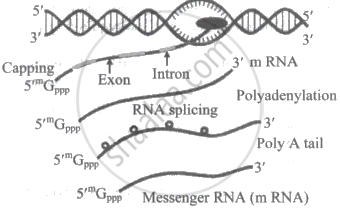Advertisements
Advertisements
Questions
Enlist the characteristics of genetic code.
Describe any three characteristics of the genetic code.
Enlist the four characteristics of the genetic code.
Write any six characteristics of genetic code.
Solution
- Genetic code is a triplet code: A sequence of three consecutive bases constitutes a codon, which specifies one particular amino acid. Base sequence in a codon is always in 5’ → 3’ direction. In every living organism, the genetic code is a triplet code.
- Genetic code has distinct polarity: Genetic code shows definite polarity, i.e., direction. It is always read in 5’ → 3’ direction and not in 3’ → 5’ direction. Otherwise, the message will change, e.g. 5’ AUG 3’.
- Genetic code is non-overlapping: Code is non-overlapping, i.e., every single base is a part of only one codon. Adjacent codons do not overlap.
- Genetic code is commaless: There is no gap or punctuation mark between successive/consecutive codons.
- Genetic code has degeneracy: Usually, the single amino acid is encoded by a single codon. However, some amino acids are encoded by more than one codon. e.g. Cysteine has two codons, while isoleucine has three. This is called the degeneracy of the code. The degeneracy of the code is explained by the Wobble hypothesis. Here, the first two bases in different codons are identical, but the third one varies.
- Genetic code is universal: In most living organisms, the specific codon specifies the same amino acid. e.g., Codon AUG always specifies the amino acid methionine.
- Genetic code is non-ambiguous: The specific amino acid is encoded by a particular codon. Alternatively, two different amino acids will never be encoded by the same codon.
- Initiation codon and termination codon: AUG is always an initiation codon in any and every mRNA. AUG codes for the amino acid methionine. Out of 64 codons, three, viz., UAA, UAG, and UGA, are termination codons that terminate or stop the process of elongation of a polypeptide chain, as they do not code for any amino acid.
- Codon and anticodon: A codon is a part of DNA, e.g., AUG is a codon. It is always represented as 5’ AUG 3’. Anticodon is a part of tRNA. It is always represented as 3’ UAC 5’.
Notes
Students should refer to the answer according to their questions.
APPEARS IN
RELATED QUESTIONS
Attempt any TWO of the following:
Define the terms ‘codon’ and ‘anticodon’.
During elongation of polypeptide chain, sigma factor is
Which process is shown in the following diagram?

Identify the condition under which there will be no change in the reading frame of following mRNA.
5' AACAGCGGUGCUAUU 3'
In the genetic dictionary, there are 64 codons as ______
Which of the following represents the central dogma of molecular biology?
From the following identify the INCORRECT match.
Identify the process represented in the diagram given below.

If there are 300 bases in an RNA which codes for a protein with 100 amino acids, and a base at position 162 is deleted such that the length of RNA become 299, how many codons will be altered.
Select the correct statement from the following.
